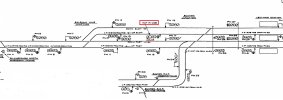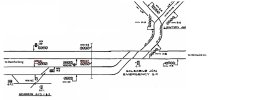Springs Branch
Established Member
A couple of recent threads on distant signals & banner repeaters reminded me of one of the great mysteries of the WCML from my youth (at least, mysterious in my mind) . . .
Why was a green aspect not available on signal PN14 ?
Here's the background:
- The attachment shows historic signalling arrangements around the Balshaw Lane Jn. / Euxton Jn. area of the WCML.
- The diagram is extracted from a BR Signalling Notice issued in 1972 during commissioning of Preston PSB.
- Where the WCML transitions from four tracks to two at Balshaw Lane Jn, the junction is protected by controlled signal PN9 on the Up Slow, with PN14 the automatic signal in rear acting as the junction's "up slow inner distant". It's still the same today.
- Euxton Balshaw Lane station is now located between those two signals, but is not shown - the station was still closed at the time.
- PN14 is marked on this diagram (and others I've seen) as not having a green aspect available - on an otherwise conventional 4-aspect TCB route.
My questions are:
However, if this were true, it doesn't make sense to have Double Yellow available on PN14. Surely PN14 could only ever display either Red or Single Yellow?
At present the Sectional Appendix shows the Slow Lines with a 75 mph speed limit, and 75 mph through the points at Balshaw Lane Jn., so presumably no need for any approach control these days.
Any ideas why this one-off anomaly existed here?

Why was a green aspect not available on signal PN14 ?
Here's the background:
- The attachment shows historic signalling arrangements around the Balshaw Lane Jn. / Euxton Jn. area of the WCML.
- The diagram is extracted from a BR Signalling Notice issued in 1972 during commissioning of Preston PSB.
- Where the WCML transitions from four tracks to two at Balshaw Lane Jn, the junction is protected by controlled signal PN9 on the Up Slow, with PN14 the automatic signal in rear acting as the junction's "up slow inner distant". It's still the same today.
- Euxton Balshaw Lane station is now located between those two signals, but is not shown - the station was still closed at the time.
- PN14 is marked on this diagram (and others I've seen) as not having a green aspect available - on an otherwise conventional 4-aspect TCB route.
My questions are:
- Does the current LED version of signal PN14 now display a green? (or is it still capable of only R, Y, YY ?)
- Why was PN14 set up this way back in 1972?
- Were there other examples of this '4-aspect with no green' elsewhere?
However, if this were true, it doesn't make sense to have Double Yellow available on PN14. Surely PN14 could only ever display either Red or Single Yellow?
At present the Sectional Appendix shows the Slow Lines with a 75 mph speed limit, and 75 mph through the points at Balshaw Lane Jn., so presumably no need for any approach control these days.
Any ideas why this one-off anomaly existed here?





